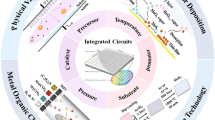Abstract
In this paper recent developments made by the French Atomic Energies and Alternative Energies Commission (CEA) at the Electronics and Information Technology Laboratory (LETI) on the fabrication of planar p-on-n HgCdTe photodiodes are reported. Results obtained on long-wavelength infrared (LWIR) liquid-phase epitaxy (LPE) and mid- and short-wavelength infrared (MWIR/SWIR) molecular beam epitaxy (MBE) have been previously published. For these photodiodes, p-type doping is obtained by arsenic implantation followed by diffusion and activation under Hg-overpressure annealing. The active layer is n-type doped by indium incorporation during growth. Control of the p-on-n junctions is one of the key points of this technology, requiring good knowledge of the arsenic implantation and diffusion and the evolution of implantation-induced defects. Concerning implantation, the impact of dose (from 2 × 1014 at./cm2 to 2 × 1015 at./cm2) and energy (from 50 keV to 500 keV) on As profiles is considered. The profiles after implantation are modeled using Pearson IV moments. Realistic descriptions of arsenic distributions are obtained, and the evolution of moments with implantation conditions is fitted. In addition, implantation damage is examined by transmission electron microscopy (TEM) and the evolution of defects is studied depending on implantation conditions and Hg-overpressure annealing. Previous results obtained on 30-μm-pitch LPE LWIR and MBE MWIR/SWIR showed state-of-the-art detector performance. Since these first results, progress has been made to decrease the pixel pitch to 15 μm and increase the focal-plane array (FPA) format. In this way, 640 × 512 LPE LWIR FPAs have been processed and characterized. In addition we report results obtained on our first p-on-n very long-wavelength infrared (VLWIR) photodiode fabricated at CEA–LETI with λ c = 13.35 μm at 50 K. These latest results demonstrate the viability of our technology and materials.
Similar content being viewed by others
References
G. Destefanis, J. Cryst. Growth 86, 700 (1988).
L. Mollard, G. Destefanis, N. Baier, J. Rothman, P. Ballet, J.P. Zanatta, M. Tchagaspanian, A.M. Papon, G. Bourgeois, and J.P. Barnes, J. Electron. Mater. 38, 1805 (2009).
L.O. Bubulac, J. Cryst. Growth 86, 723 (1988).
L.O. Bubulac, D.S. Lo, W.E. Tennant, D.D. Edwall, J.C. Chen, J. Ratusnik, J.C. Robinson, and G. Bostrup, Appl. Phys. Lett. 50, 1586 (1987).
D.G. Ashworth, R. Oven, and B. Mundane, J. Phys. D: Appl. Phys. 23, 870 (1989).
G.L. Destefanis, Nucl. Instrum. Methods 209/210, 567 (1983).
O. Gravrand, L. Mollard, C. Largeron, N. Baier, E. De Borniol, and P. Chorier, J. Electron. Mater. 38, 1733 (2009).
T. Chuh, Proc. SPIE 5563, 19 (2004).
Author information
Authors and Affiliations
Corresponding author
Rights and permissions
About this article
Cite this article
Mollard, L., Destefanis, G., Bourgeois, G. et al. Status of p-on-n Arsenic-Implanted HgCdTe Technologies. J. Electron. Mater. 40, 1830–1839 (2011). https://doi.org/10.1007/s11664-011-1692-z
Received:
Accepted:
Published:
Issue Date:
DOI: https://doi.org/10.1007/s11664-011-1692-z




